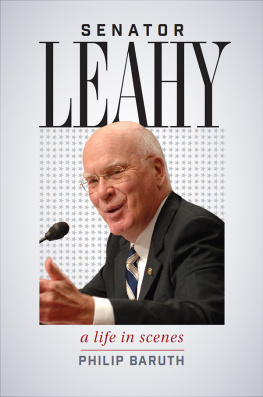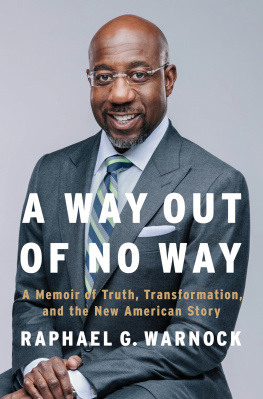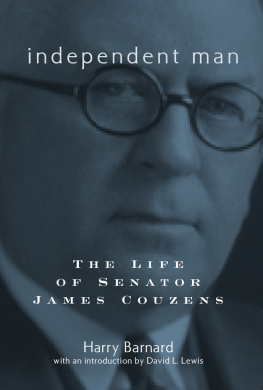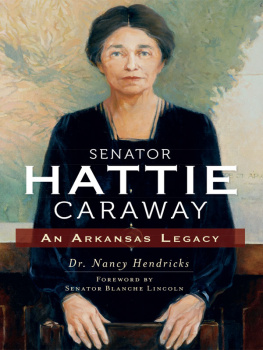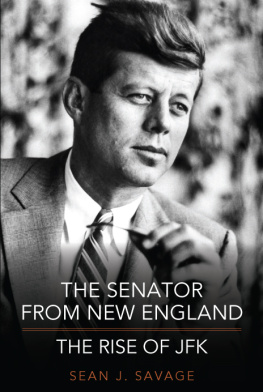Baruth Philip Edward - Senator Leahy: a life in scenes
Here you can read online Baruth Philip Edward - Senator Leahy: a life in scenes full text of the book (entire story) in english for free. Download pdf and epub, get meaning, cover and reviews about this ebook. City: Hanover, year: 2017, publisher: University Press of New England, genre: Detective and thriller. Description of the work, (preface) as well as reviews are available. Best literature library LitArk.com created for fans of good reading and offers a wide selection of genres:
Romance novel
Science fiction
Adventure
Detective
Science
History
Home and family
Prose
Art
Politics
Computer
Non-fiction
Religion
Business
Children
Humor
Choose a favorite category and find really read worthwhile books. Enjoy immersion in the world of imagination, feel the emotions of the characters or learn something new for yourself, make an fascinating discovery.
- Book:Senator Leahy: a life in scenes
- Author:
- Publisher:University Press of New England
- Genre:
- Year:2017
- City:Hanover
- Rating:5 / 5
- Favourites:Add to favourites
- Your mark:
- 100
- 1
- 2
- 3
- 4
- 5
Senator Leahy: a life in scenes: summary, description and annotation
We offer to read an annotation, description, summary or preface (depends on what the author of the book "Senator Leahy: a life in scenes" wrote himself). If you haven't found the necessary information about the book — write in the comments, we will try to find it.
The blockbuster life of Americas most senior senator
Senator Leahy: a life in scenes — read online for free the complete book (whole text) full work
Below is the text of the book, divided by pages. System saving the place of the last page read, allows you to conveniently read the book "Senator Leahy: a life in scenes" online for free, without having to search again every time where you left off. Put a bookmark, and you can go to the page where you finished reading at any time.
Font size:
Interval:
Bookmark:

ACKNOWLEDGMENTS
Among the many people who contributed to this biography, let me first list my wife, Annika, who gave me Sunday mornings free and clear to writeand who bought me the miniature recorder I used over the last five years to interview a host of Vermonters with intimate knowledge of Leahys career. All those interview subjects deserve thanks, but particularly Senator Pat Leahy and his wife Marcelle, the late Marselis Parsons, Chris Graff, Carolyn Dwyer, Toby Knox and Brian Harwood, David Schaefer, Paul Bruhn, Ed Pagano, Garrison Nelson, Luke Albee, Mary Leahy, Chief Judge Beryl Howell, US Marshal David Demag, Governor Phil Hoff, Candace Page, Senator Gary Hart, and filmmaker Dorothy Tod.
One interviewee I feel I should mention even though our meeting never actually occurred. Richard Mallary, Leahys opponent in the watershed Senate election of 1974, died just days before our scheduled interviewbut we spoke by phone for thirty minutes or so, and I immediately understood him to be as gracious as my research had indicated.
And one photographer must be thanked in a paragraph of his own. The 1974 race really came alive for me when I discovered that Sandy Milens, Leahys campaign photographer back then, lived just a few blocks from my homeand that he still had in his possession hundreds of photos from the period. This book showcases only a few of the most dramatic and illustrative, but looking through his complete archive was one of the most delightful moments of my research. And Sandy could not have been more generous in sharing his work with me, and you the reader.
David Carle and John Goodrow were of great help in providing information and background from Leahys Senate offices. Julian Smith, a promising filmmaker and my project intern for several years, contributed greatly to the chapter involving Leahys work with 1970s murder cases.
The exceptional research librarians at UVMs Bailey/Howe Library provided countless hours of assistance, as I combed through microfilm and Special Collections archives. The Vermont State Library and Saint Michaels College Library both deserve mention as well.
I owe large institutional debts to my college and to my department at the University of Vermont. From the dean of arts and sciences I received both sabbatical time to write and funds to help defray photo permission costs; my chair, Professor Val Rohy, helped in a hundred small ways to allow the writing to go forward. My friend Tony Magistrale provided indispensable wisdom, as always.
Finally, my thanks to my editor, Richard Pult, for green-lighting this book and for being the sort of editor who can lose himself with equal ease in political discussion or comic book trivia. And to my copy editor, Glenn Novak, for his sharp and careful eye.
Thank you all.
The Origin Story |
In one very literal sense, Patrick Joseph Leahy had a Norman Rockwell Vermont childhood. In the early summer of 1940the very year of Leahys Montpelier birththe famed illustrator Norman Rockwell abruptly relocated his small family from New Rochelle, New York, to the smaller, sleepier community of Arlington, Vermont. New Rochelle had been rocked by the high-profile kidnapping and beheading of a twelve-year-old boy, son of a prominent Manhattan attorney, and the unbelievable viciousness of the act helped spur the Rockwells to finally make their Vermont summer home a permanent residence.
The Rockwells felt that their sons would receive the bucolic, innocent childhood Rockwell himself idolized as every boys ideal, writes biographer Laura Claridge, and the personalities of the Vermonters lent themselves, the artist believed, to opening a whole new panoply of models to him.
Rockwell saw 1940s Vermont as most closely approximating the idealized world that had become his own signature, and in that unusual sense, he quite deliberately selected the boyhood that lay ahead of Pat Leahy for his own three sons. Its worth noting, too, as Claridge does, that the artist came seeking not only the reality of Vermonts innocence, but a steady stream of models with which to more elaborately (and lucratively) construct the national myth of it.
Very much like Rockwells, Leahys story would increasingly intermingle the real-life savor of small-town Vermont with a celebrity dependent on conjuring the vivid impression of that sweetness in the minds of others. From the very beginning of Patrick Leahys long and productive political life, then, Vermont myth and reality would never truly be in competition, but rather in something much richer and more complex, something that can finally only be called cahoots.

Consider, for instance, what the boy saw looming directly across Montpeliers State Street each morning, when he left for his early paper route. It was then and remains now the most distinctive single postcard image in Vermont: the golden dome, one of the nations oldest continually functioning statehouses, the dome covering its impressive rotunda gleaming with twenty-three-karat gold leaf. It would be enough to rivet the ambition of any child, but particularly one whose parents talked politics relentlessly at the supper table each and every night.
And in the autumn especially, with a boa of red and orange maples strung lavishly about it, the Statehouse was not simply the seat of state power, and the family businesss bread and butterit was also heartbreakingly beautiful, civic devotion made a lovely, solid, permanent thing.
Now consider that view from Leahys side of State Street, and close one eye. The left one.
Always tall and gangly for his age, Pat Leahy had more than the one good reason to be physically awkward: he was also born legally blind in his left eye, a fact that he has managed to keep relatively quiet over the bulk of his political life. The diagnosis was congenital toxoplasmosis, an infection produced by the Toxoplasma gondii parasite and passed unknowingly from his mother at birth. The parasite reproduces only in cats (with litter boxes being the most common site of infection), and Alba Leahylike many of those afflictedapparently experienced no symptoms.
But although Leahys sight was severely affected, doctors considered the family fortunate that both eyes were not compromised. Still, the boys monocular field of vision was from the outset significantly smaller than normal, and almost entirely lacking in stereopsis, the perception of depth. Leahy has little to no peripheral vision to this day, but he compensated as he grew by swiveling his head more from side to side to increase that visual field. The tilting, rolling mannerism carried just a trace of bashfulness, and with his thick glasses and unusual early height, it all combined for the pleasant impression of a gentle giant.
But these same factors also made it very easy to stumble, growing up, and very hard to coordinate hand to eye. Leahy became a physically deliberate boy, slower in his walk than most kids his age, careful on stairs or a bicycle. He was told, many times and in many different ways over the years, that one injury to his good eye could leave him truly blind. So it was a workable handicap, but it cost him in myriad ways.
Sportsat least the popular team sportswere out.
Mary Leahy singles out the high school basketball team as something that her older brother wanted very badly, and was denied. Saint Michaels was a tiny, tiny little school, and it had a tiny, tiny little basketball team, and because he was so tall, that would have been something hed have lovedbut he couldnt, because he just had no peripheral vision or depth vision, so a ball could come at him. So what he did was become the manager of the team, and he was very involved with that. But I always kind of felt that he wished mightily that he could be out there playing.
Font size:
Interval:
Bookmark:
Similar books «Senator Leahy: a life in scenes»
Look at similar books to Senator Leahy: a life in scenes. We have selected literature similar in name and meaning in the hope of providing readers with more options to find new, interesting, not yet read works.
Discussion, reviews of the book Senator Leahy: a life in scenes and just readers' own opinions. Leave your comments, write what you think about the work, its meaning or the main characters. Specify what exactly you liked and what you didn't like, and why you think so.

